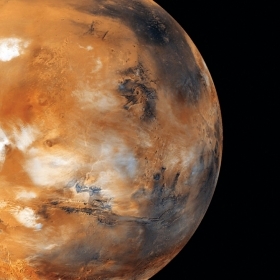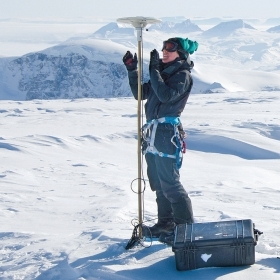For Abigail Harrison ’19, traveling to Mars is a goal she’s been working toward since she was a child, and thousands of people on social media and online have been watching her chase it since she was in the eighth grade.

Photo by Richard Howard
When Abigail Harrison ’19 was growing up in Minneapolis, sometimes in the winter, before school, she’d walk to a park near her house that had an ice-skating rink. As she enjoyed a few solitary spins around the rink, she’d look back at her footprints in the snow, the only sign of humanity, and a frisson would run through her. She’d imagine being on the surface of Mars, looking back at her footprints, knowing she was the first human to ever walk that path.
Many people have had daydreams like this, but for Harrison, traveling to Mars is more than a dream. It’s a goal she’s been working toward since she was a child, and thousands of people on social media and online have been watching her chase it since she was in the eighth grade. That’s when she created an online presence, “Astronaut Abby,” as part of her award-winning State History Day project, “Debate and Diplomacy: The History of the ISS [International Space Station].” Very early on, Harrison showed an unusual facility for social media and connected with space station engineer Susan Freeman and other scientists. She wrote on her blog about the project, “Given the importance of the International Space Station to the future of space, including sending humans to Mars, I thought it was a perfect project. My generation, the Mars Generation, will make it to Mars because of the hard work of all the people and countries involved in the ISS.”
In the spring of 2011, Harrison traveled to the Kennedy Space Center to watch the space shuttle Endeavour launch on STS-134. On her way home, she serendipitously met European Space Agency astronaut Luca Parmitano, who was behind her in the security line at the airport. Parmitano offered to chat with Harrison before their flights. Harrison remembers Parmitano advising her, “Follow your heart in your studies and do what you love. NASA is looking for people who are passionate about what they do.” Parmitano and Harrison kept in touch, and he became her mentor.
‘It was the middle of the night, but it looked like it was daytime, because this rocket was so bright. And you could feel the heat on your face.’
Two years later, in May 2013, when Harrison was a high-school sophomore, Parmitano invited her to be his special guest at the launch of Soyuz-TMA-09M, when he traveled to the International Space Station. It was the opportunity of a lifetime, but it came with a big price tag—it cost $20,000 to travel to Baikonur, Kazakhstan. Undaunted, Harrison used her social media skills to raise the money she needed for the trip. It was well worth it, Harrison says. During the launch, she was less than a mile from the Soyuz. “It was one of the most amazing things I’ve seen in my life, because when it launches, it lights up the entire sky. It was the middle of the night, but it looked like it was daytime, because this rocket was so bright. And you could feel the heat on your face,” Harrison says. While Parmitano was in space, Harrison was his “Earth liaison,” sharing Parmitano’s space mission with her followers and other young people interested in space.
At Wellesley, Harrison is taking Parmitano’s advice and following her academic passions. She is majoring in astrobiology—a self-made major—and Russian area studies. One of her most memorable experiences so far has been taking Lake Baikal: The Soul of Siberia, a course offered by the Russian and biology departments, which included a trip to Lake Baikal last summer. She also helps run the Mars Generation, a nonprofit that she founded before leaving for Wellesley that is focused on inspiring and exciting people about space exploration and STEM. After she graduates, she plans on entering a Ph.D. program somehow related to astrobiology. “It’s still up for question where or in what, because astrobiology is such a new and upcoming field,” she says. And after that? With luck, her path will include those first footsteps on Mars.


